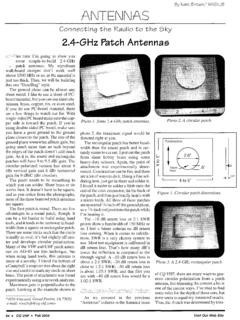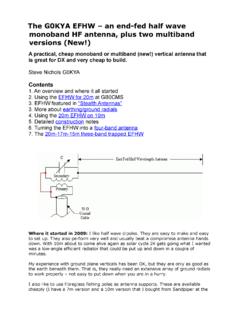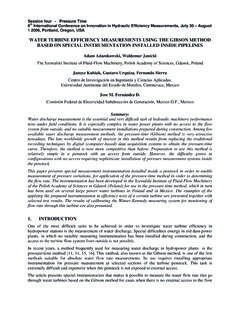Transcription of Measurements of Environmental Electromagnetic …
1 FCC/OET ASD-9601. Measurements OF Environmental . Electromagnetic FIELDS AT. AMATEUR RADIO STATIONS. Robert F. Cleveland, Jr. Office of Engineering and Technology Federal Communications Commission Washington, 20554. Edwin D. Mantiply National Air and Radiation Environmental Laboratory Environmental Protection Agency Montgomery, Alabama 36115-2601. ACKNOWLEDGEMENTS. The authors would like to extend their sincere appreciation to the amateur radio operators who participated in this study. Without their cooperation and the donation of their time and assistance this study would not have been possible.
2 In particular, we would like to thank Dr. Wayne Overbeck for contacting amateur radio operators in the Los Angeles area and for helping us coordinate the study. The late Harold L. Crispell performed a similar function in the San Diego area, and we would like to express our appreciation to his family. We would also like to acknowledge the valuable assistance of Toni L. West, of the EPA's Las Vegas, Nevada, laboratory facility, in carrying out this study and in assisting in analysis of the data. Thanks are also due to Jerry Ulcek of the FCC for help in preparing the tables incorporated into this report and to Larry Petak, Steve Houck and David Sylvar of the FCC for reviewing and offering suggestions for improving the report.
3 I EXECUTIVE SUMMARY. In order to obtain data on Environmental radiofrequency (RF) fields in the vicinity of amateur radio stations, the Federal Communications Commission (FCC) and the Environmental Protection Agency (EPA) conducted a joint measurement study of nine amateur stations in southern California. This information will be useful to the FCC in determining how to implement newly revised guidelines for human exposure to RF. energy. Amateur stations were chosen that represented a variety of antenna and equipment types, many of which are commonly used by amateur radio operators licensed by the FCC.
4 Measurements of electric and magnetic field strength were made in areas near amateur antennas and equipment in order to determine typical and "worst case". exposure levels of amateur radio operators, their families and other individuals who live or work in the vicinity of these stations. Measurements were made using instrumentation appropriate for the particular transmitting frequency being used at a given location. Both broadband and narrowband instruments were used. For most of the stations surveyed, current RF protection guidelines for field strength and power density were not exceeded in accessible areas.
5 The highest readings in accessible areas were generally associated with vehicle-mounted antennas. However, when "duty factors" are taken into account routine exposures from such antennas would be expected to comply with safety guidelines. If maximum permissible power levels and different facility configurations are used, higher exposure levels than those measured here cannot be ruled out. Such exposures could affect the amateur operator or other individuals in the immediate vicinity of a station. However, it is concluded that appropriate precautionary measures and facility siting should be sufficient to prevent exposures that are in excess of safety guidelines.
6 Ii TABLE OF CONTENTS. introduction .. 1. measurement PROCEDURES AND instrumentation .. 2. RESULTS AND DISCUSSION .. 2. REFERENCES .. 7. TABLE 1: SUMMARY OF AMATEUR STATIONS SURVEYED .. 8. TABLE 2: EXAMPLES OF MAXIMUM ELECTRIC FIELDS IN PUBLICLY. ACCESSIBLE AREAS .. 9. TABLE 3: EXAMPLES OF MAXIMUM MAGNETIC FIELDS IN PUBLICLY. ACCESSIBLE AREAS .. 10. TABLE 4: EXAMPLES OF FIELDS AT OPERATOR LOCATIONS .. 11. APPENDIX A: STATION DESCRIPTIONS AND measurement RESULTS . 13. APPENDIX B: SUMMARY OF ANSI AND IEEE RECOMMENDED FIELD LIMITS51.
7 Iii introduction . There are more than 500,000 licensed amateur radio operators in the United States and many more throughout the world. Consequently, there is potential for human exposure to radiofrequency (RF) Electromagnetic fields due to amateur radio stations. Because of its responsibilities under the terms of the National Environmental Policy Act (NEPA), the Federal Communications Commission (FCC) has an interest in ensuring that FCC-regulated transmitters do not expose the public to levels of RF. energy in excess of accepted RF safety guidelines.
8 Since 1985, human exposure to RF fields has been one of several Environmental factors considered by the FCC in evaluating potential Environmental impact from facilities and equipment it More recently, as discussed later, the FCC has proposed to adopt new guidelines for evaluating human exposure to RF energy. In order to obtain data on the potential Environmental impact of transmissions from amateur radio stations, personnel from the FCC and the Environmental Protection Agency (EPA) measured Electromagnetic fields at several stations in southern California in July, 1990.
9 Measurements of electric and magnetic field strength were made in areas near antennas and transmitting equipment in order to determine potential levels of exposure to RF radiation for amateur operators and other individuals who may be present in the immediate vicinity of amateur stations. Some Measurements of operator exposure to 60-hertz magnetic fields were also made because of interest by the EPA in the extremely-low-frequency (ELF) Electromagnetic environment. Data obtained as a result of this study will assist the FCC in determining how to ensure compliance with new RF guidelines that may be adopted in the near future.
10 Nine amateur stations were selected for this study based on several factors, including availability of the operator during the study period, the variety of antennas and equipment at the station, the variety of available frequencies, and accessibility of the transmitting site. Participation in the study was voluntary. The southern California location was chosen primarily because of its proximity to the EPA laboratory in Las Vegas, Nevada, where the EPA personnel, measurement vehicle, and most of the measuring equipment were located.















